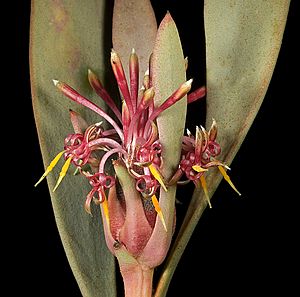Isopogon pruinosus facts for kids
Quick facts for kids Isopogon pruinosus |
|
|---|---|
 |
|
| Isopogon pruinosus subsp. glabellus | |
| Scientific classification | |
| Genus: |
Isopogon
|
| Species: |
pruinosus
|
 |
|
| Occurrence data from Australasian Virtual Herbarium | |
| Synonyms | |
|
Isopogon sp. 'Watheroo' (D.Foreman 477) auct. non WA Herbarium |
|
Isopogon pruinosus is a type of flowering plant. It belongs to the Proteaceae plant family. This plant grows only in the southwestern part of Western Australia. This means it is endemic to that area. It's a small, spreading bush with long, narrow leaves. Its flowers are pink and grow in round or oval-shaped clusters.
Contents
What Does Isopogon pruinosus Look Like?
Isopogon pruinosus is a shrub, which is a type of bush. It usually grows to about 2 meters (6.5 feet) tall and wide. Its branches are brownish and mostly smooth.
The leaves of this plant are a bluish-green color. They grow one after another along the branches. Each leaf has smooth edges. The leaves are shaped like a narrow egg, wider at the top and narrower at the bottom. They are about 30 to 85 millimeters (1.2 to 3.3 inches) long. They are also about 6 to 20 millimeters (0.2 to 0.8 inches) wide. The leaves connect to the branch with a short stem called a petiole.
The flowers grow in round or oval clusters. Each cluster has between sixteen and thirty-two flowers. These clusters are about 15 to 25 millimeters (0.6 to 1 inch) across. At the bottom of each flower cluster are three or four layers of broad, egg-shaped leaves called bracts. The flowers themselves are red or pink. They are covered in tiny hairs that lie flat against the surface. After the flowers, the plant produces small, hairy nuts. These nuts are about 3.5 millimeters (0.14 inches) long. They join together to form a round head about 8 to 12 millimeters (0.3 to 0.5 inches) wide.
How Isopogon pruinosus Got Its Name
The plant Isopogon pruinosus was officially named in 2010. Two botanists, Michael Hislop and Barbara Rye, described it. They published their findings in a science journal called Nuytsia.
Within the same journal, Hislop and Rye also described two slightly different types of this plant. These are called subspecies.
- Isopogon pruinosus subsp. glabellus: This subspecies has leaves that are 30 to 45 millimeters (1.2 to 1.8 inches) long. They are 6 to 10 millimeters (0.2 to 0.4 inches) wide. Its flowers are 11 to 15 millimeters (0.4 to 0.6 inches) long. They bloom in May, June, or September. This type mostly differs because its bracts (the small leaves near the flowers) are smooth or almost smooth.
- Isopogon pruinosus subsp. pruinosus: This subspecies has leaves that are 25 to 85 millimeters (1 to 3.3 inches) long. They are 4 to 17 millimeters (0.16 to 0.7 inches) wide. Its flowers are 15 to 21 millimeters (0.6 to 0.8 inches) long. They bloom in May, July, August, or September. This type has very hairy bracts.
The name pruinosus means "frosted" or "covered with hoar frost." This refers to a white coating often seen on this plant. The name glabellus means "without hairs." This describes the almost smooth bracts of that subspecies.
Where Isopogon pruinosus Lives
Both types of Isopogon pruinosus grow in specific areas of Western Australia. They are found in heath or mallee woodland. These areas are part of the Avon Wheatbelt, Esperance Plains, and Mallee regions.
Subspecies glabellus grows from Corrigin up to north of Hyden. Subspecies pruinosus is found from southwest of Hyden to Frank Hann National Park. There is also a separate group of this subspecies in the Fitzgerald River National Park.
Conservation Status
The Western Australian Government's Department of Parks and Wildlife has looked at both subspecies of Isopogon pruinosus. They have classified them as "not threatened." This means they are not currently at risk of disappearing.

